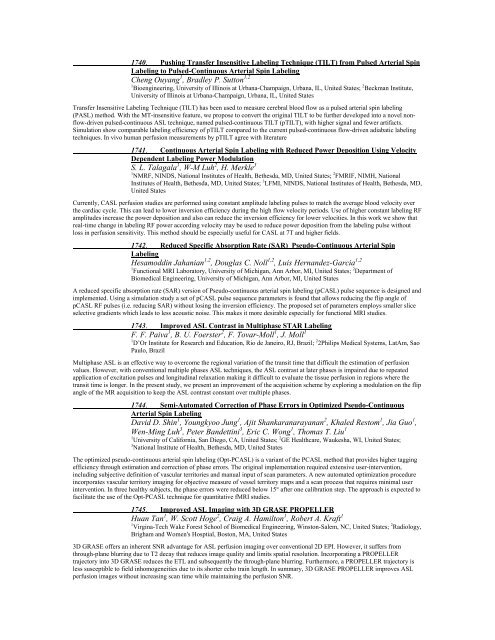Traditional Posters: Diffusion & Perfusion - ismrm
Traditional Posters: Diffusion & Perfusion - ismrm
Traditional Posters: Diffusion & Perfusion - ismrm
You also want an ePaper? Increase the reach of your titles
YUMPU automatically turns print PDFs into web optimized ePapers that Google loves.
1740. Pushing Transfer Insensitive Labeling Technique (TILT) from Pulsed Arterial Spin<br />
Labeling to Pulsed-Continuous Arterial Spin Labeling<br />
Cheng Ouyang 1 , Bradley P. Sutton 1,2<br />
1 Bioengineering, University of Illinois at Urbana-Champaign, Urbana, IL, United States; 2 Beckman Institute,<br />
University of Illinois at Urbana-Champaign, Urbana, IL, United States<br />
Transfer Insensitive Labeling Technique (TILT) has been used to measure cerebral blood flow as a pulsed arterial spin labeling<br />
(PASL) method. With the MT-insensitive feature, we propose to convert the original TILT to be further developed into a novel nonflow-driven<br />
pulsed-continuous ASL technique, named pulsed-continuous TILT (pTILT), with higher signal and fewer artifacts.<br />
Simulation show comparable labeling efficiency of pTILT compared to the current pulsed-continuous flow-driven adiabatic labeling<br />
techniques. In vivo human perfusion measurements by pTILT agree with literature<br />
1741. Continuous Arterial Spin Labeling with Reduced Power Deposition Using Velocity<br />
Dependent Labeling Power Modulation<br />
S. L. Talagala 1 , W-M Luh 2 , H. Merkle 3<br />
1 NMRF, NINDS, National Institutes of Health, Bethesda, MD, United States; 2 FMRIF, NIMH, National<br />
Institutes of Health, Bethesda, MD, United States; 3 LFMI, NINDS, National Institutes of Health, Bethesda, MD,<br />
United States<br />
Currently, CASL perfusion studies are performed using constant amplitude labeling pulses to match the average blood velocity over<br />
the cardiac cycle. This can lead to lower inversion efficiency during the high flow velocity periods. Use of higher constant labeling RF<br />
amplitudes increase the power deposition and also can reduce the inversion efficiency for lower velocities. In this work we show that<br />
real-time change in labeling RF power according velocity may be used to reduce power deposition from the labeling pulse without<br />
loss in perfusion sensitivity. This method should be especially useful for CASL at 7T and higher fields.<br />
1742. Reduced Specific Absorption Rate (SAR) Pseudo-Continuous Arterial Spin<br />
Labeling<br />
Hesamoddin Jahanian 1,2 , Douglas C. Noll 1,2 , Luis Hernandez-Garcia 1,2<br />
1 Functional MRI Laboratory, University of Michigan, Ann Arbor, MI, United States; 2 Department of<br />
Biomedical Engineering, University of Michigan, Ann Arbor, MI, United States<br />
A reduced specific absorption rate (SAR) version of Pseudo-continuous arterial spin labeling (pCASL) pulse sequence is designed and<br />
implemented. Using a simulation study a set of pCASL pulse sequence parameters is found that allows reducing the flip angle of<br />
pCASL RF pulses (i.e. reducing SAR) without losing the inversion efficiency. The proposed set of parameters employs smaller slice<br />
selective gradients which leads to less acoustic noise. This makes it more desirable especially for functional MRI studies.<br />
1743. Improved ASL Contrast in Multiphase STAR Labeling<br />
F. F. Paiva 1 , B. U. Foerster 2 , F. Tovar-Moll 1 , J. Moll 1<br />
1 D’Or Institute for Research and Education, Rio de Janeiro, RJ, Brazil; 2 2Philips Medical Systems, LatAm, Sao<br />
Paulo, Brazil<br />
Multiphase ASL is an effective way to overcome the regional variation of the transit time that difficult the estimation of perfusion<br />
values. However, with conventional multiple phases ASL techniques, the ASL contrast at later phases is impaired due to repeated<br />
application of excitation pulses and longitudinal relaxation making it difficult to evaluate the tissue perfusion in regions where the<br />
transit time is longer. In the present study, we present an improvement of the acquisition scheme by exploring a modulation on the flip<br />
angle of the MR acquisition to keep the ASL contrast constant over multiple phases.<br />
1744. Semi-Automated Correction of Phase Errors in Optimized Pseudo-Continuous<br />
Arterial Spin Labeling<br />
David D. Shin 1 , Youngkyoo Jung 1 , Ajit Shankaranarayanan 2 , Khaled Restom 1 , Jia Guo 1 ,<br />
Wen-Ming Luh 3 , Peter Bandettini 3 , Eric C. Wong 1 , Thomas T. Liu 1<br />
1 University of California, San Diego, CA, United States; 2 GE Healthcare, Waukesha, WI, United States;<br />
3 National Institute of Health, Bethesda, MD, United States<br />
The optimized pseudo-continuous arterial spin labeling (Opt-PCASL) is a variant of the PCASL method that provides higher tagging<br />
efficiency through estimation and correction of phase errors. The original implementation required extensive user-intervention,<br />
including subjective definition of vascular territories and manual input of scan parameters. A new automated optimization procedure<br />
incorporates vascular territory imaging for objective measure of vessel territory maps and a scan process that requires minimal user<br />
intervention. In three healthy subjects, the phase errors were reduced below 15° after one calibration step. The approach is expected to<br />
facilitate the use of the Opt-PCASL technique for quantitative fMRI studies.<br />
1745. Improved ASL Imaging with 3D GRASE PROPELLER<br />
Huan Tan 1 , W. Scott Hoge 2 , Craig A. Hamilton 1 , Robert A. Kraft 1<br />
1 Virgina-Tech Wake Forest School of Biomedical Engineering, Winston-Salem, NC, United States; 2 Radiology,<br />
Brigham and Women's Hosptial, Boston, MA, United States<br />
3D GRASE offers an inherent SNR advantage for ASL perfusion imaging over conventional 2D EPI. However, it suffers from<br />
through-plane blurring due to T2 decay that reduces image quality and limits spatial resolution. Incorporating a PROPELLER<br />
trajectory into 3D GRASE reduces the ETL and subsequently the through-plane blurring. Furthermore, a PROPELLER trajectory is<br />
less susceptible to field inhomogeneities due to its shorter echo train length. In summary, 3D GRASE PROPELLER improves ASL<br />
perfusion images without increasing scan time while maintaining the perfusion SNR.















